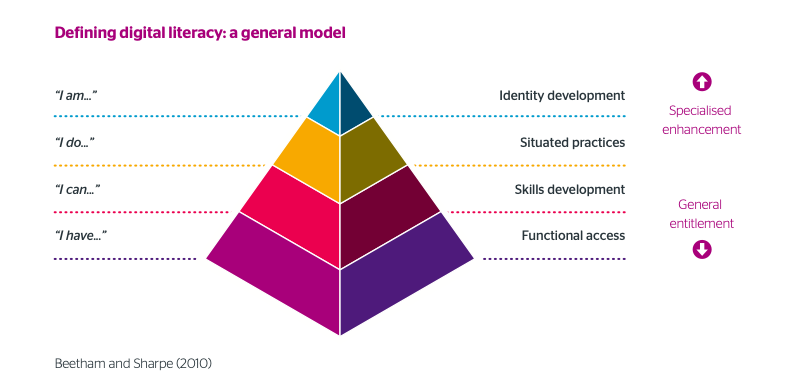The resource that I explored this week was a 2015 article published by Jisc, a UK-based digital, data, and technology agency, entitled “Developing Students’ Digital Literacy.” It was referenced in Catherine Cronin’s 2017 article “Openness and Praxis: Exploring the Use of Open Educational Practices in Higher Education,” and focuses on the increasing importance of digital literacy in the modern educational environment. It explores how students’ ability to effectively use digital tools, platforms, and resources is becoming essential for their academic success, career prospects, and participation in society, emphasizing that “[e]mployers are increasingly recognising the benefits of employing people with the knowledge and skill to harness the potential of technologies and social media and may use this to differentiate between potential employees” (Jisc, 2015, p. 3). The article defines digital literacy as not just technical skills, but as a broad range of abilities, including information and media literacy, critical thinking, creativity, communication, and collaboration.

One of the aspects of the article that I found the most interesting was the digital literacy model by Beetham and Sharpe (2010), which presents a layered approach to understanding how digital skills and awareness develop. Although the article does not focus on this diagram in-depth, I was able to form my own understanding of what it was demonstrating. In my opinion, the pyramid structure helps visualize a progression from simply having access to digital tools (“I have…”), to gaining essential skills (“I can…”), applying those skills in real-world contexts (“I do…”), and finally, integrating digital practices into one’s identity (“I am…”). This model goes beyond just technical ability; it highlights how digital literacy is deeply connected to confidence, context, and personal development. The distinction between general entitlement at the foundational levels and specialised enhancement at the higher levels reinforces the idea that everyone needs basic digital access and skills, but also that there’s room for deeper, more personalized growth.
Overall, I found this article to be very interesting, and definitely relevant to not only what we are learning in this course, but the present and future of our society as well.
hannedeener
June 11, 2025 — 9:39 pm
Hello Anna!
Wow, I really like that you chose to use the visual of a General Model for Defining Digital Literacy and found your reflection on the concept quite succinct yet interesting. I’m curious if you’ve ever seen this model before or perhaps just heard the language style used? I expect this kind of language, as moving from more concrete to abstract, has been utilized in other areas of students’ learning. For example, I know teachers like to encourage growth mindset language such as using the word ‘yet’ at the end of definitive, negative sentences such as, “I don’t know the answer… yet.” I presume the model uses a similar approach wherein it encourages a mindset shift and thus a behavioural shift as well.
All in all, I really like the layout of your blog post and appreciate you sharing your perspective on this article and on Developing Students’ Digital Literacy as a whole.